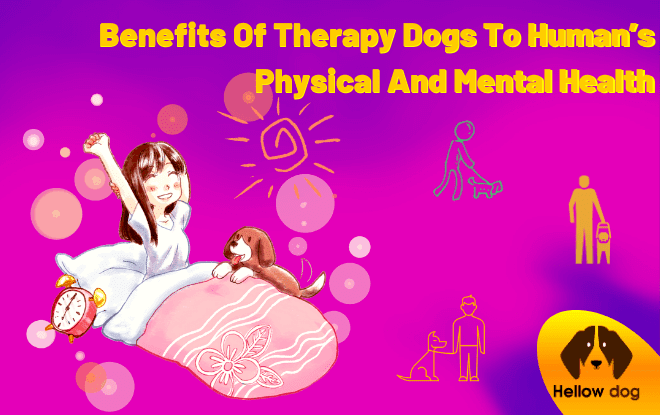Dogs are one of the most affectionate pets in the world that one way or another, they always make us happy and just want to play with them.
And what if we are sad or injured?
As long as they wag their tails running around or lick our faces, everything seems to get better.
That’s why some of them are trained to bring love to those who have difficulty treating their diseases. These are called therapy dogs.
[tcb-script async=”” src=”https://pagead2.googlesyndication.com/pagead/js/adsbygoogle.js”][/tcb-script][tcb-script] (adsbygoogle = window.adsbygoogle || []).push({});[/tcb-script]
So, what are therapy dogs? How a therapy dog can help a person mentally and physically?
Those are the issues that we will cover in this article. Besides, you can also have a therapy dog for yourself through our therapy dog training guides. Do not miss it.


Therapy dogs in hospitals
What are Therapy Dogs?
A number of studies have shown a link between pets and people who have health problems or mental disorders. Therefore, after years of research and testing, pet therapy has been created with the purpose of helping those people recover or cope with their difficulties.
Common animals used in pet therapy include dogs, cats, fish, guinea pigs, horses, etc.
As such, therapy dogs are pets that are trained to be friendly and gentle with people around them. They are also very patient just to make people feel comfortable and happy.
Therapy dogs may live indoors or go to hospitals, schools, nursing homes, etc. to help those who need love and motivation to live. This form of therapy dogs international is very popular in countries like the United States.
Here are some specific purposes for therapy dogs:
- Promote motor skills and joint movement
- Increase assisted or independent movement
- Improve self-esteem
- Develop verbal communication
- Improve social skills
- Promote willingness to join in activities
- Motivate interactions with others
- Promote willingness to exercise
[tcb-script async=”” src=”https://pagead2.googlesyndication.com/pagead/js/adsbygoogle.js”][/tcb-script][tcb-script] (adsbygoogle = window.adsbygoogle || []).push({});[/tcb-script]
Which Kinds of Dogs Can be Therapy Dogs?
Any dog can be trained to be a useful therapy dog, as long as they are friendly and gentle. However, when it comes to popularity, large dogs will include golden retrievers, standard poodles, St. Bernards, and Labradors. Meanwhile, small-size dogs include mini poodles and Pomeranians.
How to Become a Therapy Dog
These dogs need to have a health check to ensure that they have been immunized and are free of any disease before being trained to become therapy dogs. After that, organizations will allow dogs to take part in an obedience training course and an instructional course to control and promote them to interact with people.
Finally, they will assess the temperament and behavior of pets with the therapy dog breeders before approving and certifying them as therapy dogs.


Therapy dog training
Therapy Dog vs. Service Dog
You may get confused between service dogs and therapy dogs.
Sometimes, walking in restaurants, hotels, or on the sidewalk, you’ll notice a blind person being led by a dog. The dog is called a service dog.
In addition to being trained to help people with disabilities, bring them safety and independence, service dogs have no other pet-related task. That’s because stroking or playing with them will prevent them from doing their duty. Some dog owners even have a “no petting” policy.
Therapy dogs have a similarity to service dogs as they are also trained to help people. However, they act as pets, support, and provide psychological or physiotherapy for patients or people with mental instability. They are friendly, approachable, and are encouraged to interact with people.
In general, service dogs and therapy dogs vary in training method and purpose.
Who Should Try Therapy Dogs
- Those who undergo chemotherapy
- Those who need to regain motor skills
- Those who have chronic heart failure
- Residents in long-term care facilities
- Children having physical or dental procedures
- Veterans with post-traumatic stress disorder
- Those with mental health disorders
However, if you are allergic to dog hair, this treatment will not be suitable for you.On the other hand, during therapy, dogs may be injured or abused, treated inappropriately. So, if you have children who need therapy dogs, always be with your child during treatment so that there is no unfortunate problem.
What Can They Do For Our Health Condition?
As we said, therapy dogs have a vital role in reducing stress levels, bringing calm, affection, and comfort in some particular cases. So what are the special cases here?
These are people with mental health problems, people who are recovering from trauma, surgery, patients who accept chemotherapy, radiation, heart patients, etc., especially children patients.
Besides, it will be a shortcoming if we forget those with depression and autism (in children). One thing is for sure that children love animals, especially dogs. If your child is afraid of dogs, do not worry because there are many smaller dog species that can help your child.
In other words, therapy dogs are widely used in hospitals, schools, and universities, where most of the people with the problems we have mentioned above are concentrated.
In Hospitals
In hospitals, patients can receive Animal-Assisted Therapy (AAT), which is interacting with friendly dogs running around the hospital rooms. Thanks to that, they can recover faster.
When we are sick or suffer from mental difficulties, we will be anxious, stressed, unable to sleep or eat as well as usual. In the case of physical pain, we will see everything seems to get worse and worse, and that mental instability will make the wound take longer to recover.
Many studies have demonstrated the positive degree that a therapy dog affects mental health and mental disorders. Specifically, communicating with them will help patients with depression, ADHD, bipolar disorder, post-traumatic stress disorder (PTSD), autism, and even Alzheimer’s disease, etc. can overcome and heal faster.
Why Is There Such a Miracle?
According to top studies, enjoying a good time with your pet can stimulate your body to increase oxytocin and dopamine hormones. They are two of the hormones produced when we are happy and cheering. Stress hormones, such as cortisol, are reduced, helping people to be free from anxiety.
Therapy dog benefits also occur with heart patients.
Why do we want to mention this disease alone? That’s because, today, busy and stressful lifestyles have made heart disease more and more popular, especially with the young.
Being close to pets will promote human emotions, from which the blood circulation will also work better, helping the cardiovascular system be improved. If you are having the same problem, see a therapy dog several times a week.
Dogs may be banned in certain areas due to hygiene and infection regulations. However, therapy dogs, to be certified, have been checked on health and vaccine situation. Therefore, they absolutely do not cause disease or danger to patients.
If there is anyone surrounding you has Post-Traumatic Stress Disorder (PTSD), who is struggling to overcome their trauma, has a sudden change in mood, etc., let’s recommend this therapy dog service with them. Dogs are intelligent animals so they can understand the sadness and mood of their companion. If those patients have a chance to interact with them, they will recover quickly from the events or stress they have experienced.
[tcb-script async=”” src=”https://pagead2.googlesyndication.com/pagead/js/adsbygoogle.js”][/tcb-script][tcb-script] (adsbygoogle = window.adsbygoogle || []).push({});[/tcb-script]
In Universities
If you don’t know, an article from a major news site in 2018 said that 3 out of 4 college students were stressed. They are under pressure to study, take exams, and also because of expectations from their parents.
If parents do not care about their children’s psychology and health, it can lead to unfortunate cases such as failing exams or dropping out of school, even suicide. Many student suicides have occurred as a result of academic pressure, raising alarms about its severity.
In addition to adjusting teaching methods or knowledge, there are many solutions that are designed to make students feel more enjoyable and fun at school.
Fortunately, therapy dogs can help relieve stress that is related to education. These studies have shown that students who receive therapy dogs have a lower stress index than those who do not. Besides, they are also beneficial for their cardiovascular health, lowering blood pressure and reducing anxiety when the exam season comes.
As a result, the students’ moods will get better, helping them not to get stressed or depressed. It’s obvious that when the mind is clearer, they will think more precisely and can study well without anxiety.
At Schools
No doubt. The more modern society is, the more children will suffer from depression. It creates emotional, physical instability and stress for children, which makes them unwilling to interact with the community and always feel lonely.
Children with autism refuse to be exposed or feel scared when someone wants to communicate with them. However, when it comes to pets, everything is the opposite.
They seem to be more open, no longer afraid or nervous. When there are cute dogs around, children will treat them like their best friends, and their mood becomes better. As a result, autism will also be reduced, and the situation will be improved faster.
Providing a therapy dog at school will help improve the living and learning environment of children. It brings many emotional benefits, makes children’s mood better, reduces stress, anxiety, and increases socialization.
At the Nursing Homes
You might think that nursing homes have enough health workers to care for the elderly. However, therapy dogs have become more popular these days, and they are often there to help older people feel happier. In particular, they are especially helpful for Alzheimer’s patients.
For people with Alzheimer’s, they have a brain disorder, which leads to impaired memory and thinking. The functions are destroyed, resulting in them not knowing how to do everything, even the simplest things like brushing their teeth.
The disease is quite complicated and incurable. However, with persistent treatment, their memory can be maintained, and they will also improve when they learn how to function.
In this case, therapy dogs work to help patients no longer worry or confuse but focus on working. They will also feel calm and happy with these four-legged friends.
[tcb-script async=”” src=”https://pagead2.googlesyndication.com/pagead/js/adsbygoogle.js”][/tcb-script][tcb-script] (adsbygoogle = window.adsbygoogle || []).push({});[/tcb-script]
How to Train a Therapy Dog?
If you are interested in training your dog into a therapy dog, you can now find many training programs, such as TDI and the Alliance of Therapy Dogs. Or, you can search for local ones at some directories online. Connect with your veterinarian and the therapy dog alliance to see if your dog is a good fit for their program.
dog needs to be happy with all the care of people” data-id=”19326″ width=”700″ height=”466″ title=”A therapy dog needs to be happy with all the care of people” src=”https://hellowdog.com/wp-content/uploads/2019/12/A-therapy-dog-needs-to-be-happy-with-all-the-care-of-people.jpg”>

A therapy dog needs to be happy with all the care of people
Besides, prepare your pet for some basic lessons, including heeling or walking on a loose leash, come, down, sit, walking past a neutral dog, and gently taking an object, etc.
In addition, familiarize him with some of the behaviors that customers can do with a therapy dog such as handling of paws, holding, staring into his eyes, yelling at him, brushing hair, extending hugs, grabbing his tail, or several people crowding him at once, etc.
A therapy dog will come with a handler. Therefore, if you want to be your pet’s handler, you must also meet some criteria for communication skills or how to handle situations like infection prevention or conflict. In addition, carefully read the policies and procedures of the establishment you plan to send your dog to for training and ensure hygiene and proper dog apparel.
For therapy dog collar/therapy dog vest, you can refer to these products:
ALBCORP Reflective Therapy Dog Vest Harness
Doggie Stylz Therapy Dog Harness
Doggie Stylz Therapy Dog in Training Vest Harness
Emotional Support Dog ESA Vest
Doggie Stylz Full-Body Lifting Dog Harness Vest
Emotional Support Service Dog mesh Vest Harness
If you feel your dog is friendly, gentle, and cares about the people around you, then you can try training him so he can help many people.
Outlook
Therapy dogs not only bring benefits to people who are suffering physically and mentally, but they are also the reason for making the world more beautiful. Hopefully, with the knowledge of “How A Therapy Dog Can Help a Person Mentally and Physically?” you will have more motivation to overcome your problems.
If you need further guides, feel free to contact us or leave your comment below. Don’t hesitate to like and share the article with others if you find it useful. Thank you!
You May Also Like
[tcb-script async=”” src=”https://pagead2.googlesyndication.com/pagead/js/adsbygoogle.js”][/tcb-script][tcb-script] (adsbygoogle = window.adsbygoogle || []).push({});[/tcb-script]







